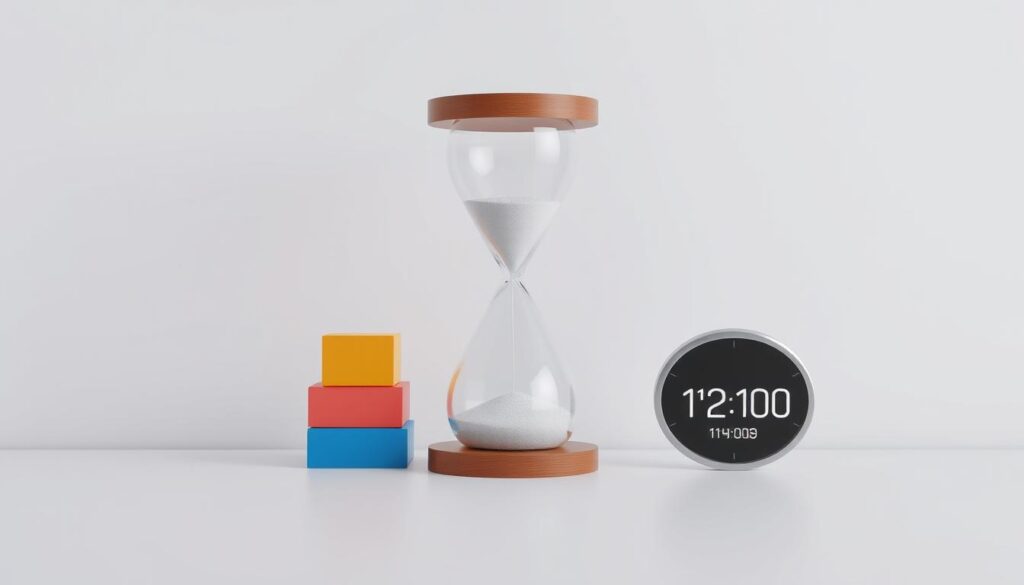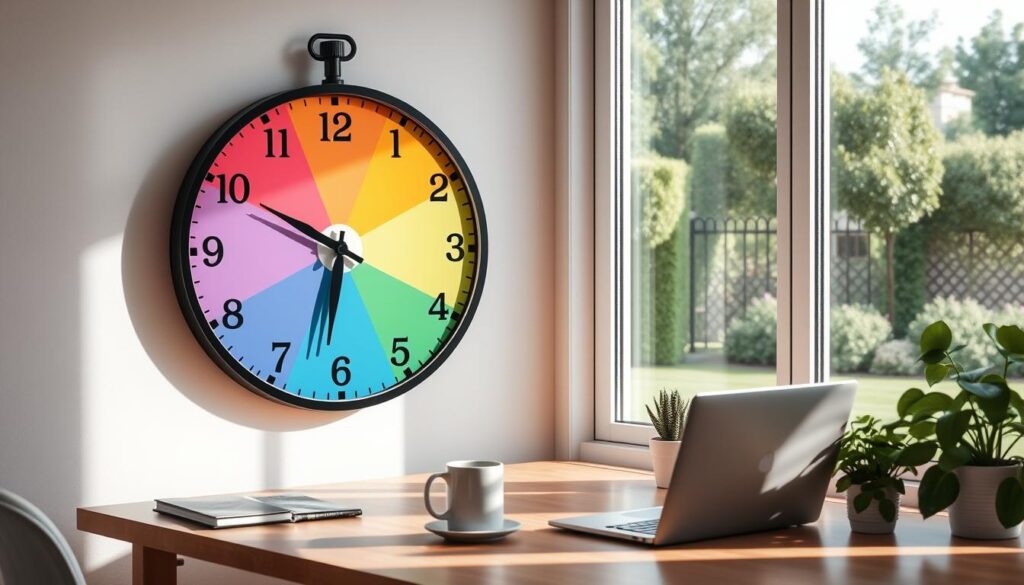“Timeboxing is a powerful tool that can transform the way you work and live. It’s about taking control of your time and making every moment count.” – Peter Drucker, acclaimed management consultant and author.
In today’s fast-paced world, distractions and overwhelming workloads are common. Finding effective time management strategies is key for success. Timeboxing is a well-studied method for getting things done. It involves setting a fixed time for a task or activity, helping you stay focused and productive.
Timeboxing uses the “setting an implementation intention” technique, planning out tasks and when to do them1. Despite its effectiveness, many don’t use it. They might be hesitant to plan every minute of their day1. Others might spend time looking for excuses, known as “what-aboutism.”1
Key Takeaways
- Timeboxing is a powerful time management technique that helps you stay focused and productive.
- It involves allocating a fixed period of time for specific tasks, promoting better prioritization and a sense of accomplishment.
- Timeboxing can be applied to individual tasks, team projects, and even meetings for maximum efficiency.
- Overcoming psychological barriers, such as resistance to planning, is key to successfully implementing timeboxing.
- Timeboxing can be combined with other productivity techniques for a complete time management approach.
What is Timeboxing?
Timeboxing is a method to manage time by setting a fixed time for a task. It helps people stay focused and avoid distractions. This way, they can work more efficiently by limiting their time2.
Breaking big tasks into smaller ones of 1-2 hours can make them easier to start and complete. It also helps in planning meetings better, like in Agile software development23.
James Martin first talked about timeboxing in his book on agile software development3. It means setting a fixed time for an activity and doing it within that time3. The process includes picking tasks, setting goals, and rewarding yourself after completing them3.
Timeboxing can greatly improve productivity by limiting time on tasks you don’t like. It helps you manage your time better and stay motivated3.
Timeboxing boosts productivity by working in focused periods. The Pomodoro technique, for example, works well for this. It involves 25 minutes of work and a 5-minute break4.
Tools like Lucidchart can also help manage time and track progress. This leads to better results4.
Benefits of Timeboxing
Timeboxing is a great way to manage your time. It helps you focus and avoid wasting time on non-essential tasks5. You can also boost your productivity and tackle procrastination5.
One big plus of timeboxing is how it improves your focus5. By setting a time limit, you stay on track and avoid distractions. This leads to better work and a sense of accomplishment5.
It also fights procrastination by making you feel like you have to get things done5. Knowing you have a deadline helps you stay motivated and finish tasks on time5.
Timeboxing also helps you prioritize better5. You have to pick the most important tasks to do first. This makes your time more efficient and boosts productivity.
It’s also great for Agile and Scrum teams5. These teams use timeboxing for meetings and tasks. It keeps everyone on the same page and meets deadlines5.
Timeboxing is good for teams too6. It helps teams work together better and avoid multitasking. It also helps plan tasks and deadlines more accurately6.
Timeboxing works for many tasks, from social media to big projects5. It helps you manage your time well and get things done. It’s a powerful tool for achieving your goals5.
“Timeboxing is a powerful tool that helps us regain control of our time and work more efficiently. By setting strict time limits, we can eliminate distractions, prioritize tasks, and achieve a greater sense of accomplishment.” – Jane Doe, Productivity Expert
| Benefit | Description |
|---|---|
| Improved Focus | Timeboxing helps eliminate distractions and keeps users on task within a set time limit5. |
| Reduced Procrastination | Timeboxing creates a sense of urgency and accountability, reducing the tendency to put off important work5. |
| Better Prioritization | Timeboxing requires users to determine the most critical tasks to tackle within a limited time frame, ensuring important work is completed first5. |
| Sense of Accomplishment | By seeing tangible progress and completion of tasks within designated time frames, timeboxing can provide a strong sense of accomplishment5. |
Timeboxing is flexible and can fit your needs6. It improves focus, reduces procrastination, and boosts productivity5. It’s useful for both personal and work tasks5.
Timeboxing as Toolkit for Time Management
Timeboxing is a great way to manage your time. It helps you work better and make the most of your time. You can use it for work, team projects, meetings, and even fun activities.
In a study of 100 productivity hacks, timeboxing was found to be the most helpful. It has five steps: set goals, decide how long to work, focus without interruptions, check your progress, and adjust as needed. By setting time blocks, you can focus better and be realistic about what you can do.
Timeboxing helps you manage your tasks and time well. It’s good to break tasks into smaller blocks of 2, 4, or 8 hours. Adding time for breaks and relaxation helps you plan your day better.
Timeboxing has many benefits. It makes you 80% more productive and helps teams meet deadlines 50% more often. It also cuts distractions by 70% and improves time management by 25%. Plus, it helps you balance work and life better.
Timeboxing works well with other productivity methods like the Pomodoro Technique or Kanban. The Pomodoro Technique is about working for 25 minutes and then taking a break. Timeboxing can be short or long, depending on the task. Using colors can help organize your time better.
Timeboxing is useful for work, team projects, or personal life. It boosts your productivity and helps you manage your time better. By using timeboxing, you can work more efficiently and enjoy a better balance between work and life.
How to Implement Timeboxing
Starting with timeboxing means you need a plan to manage your time better and work more efficiently7. First, pick tasks or activities that need a focused time limit7. Then, set clear goals for what you want to do in each timebox7.
Choosing the right time for each task is key to timeboxing success7. Don’t take on too much. Give each task enough time so you can work without feeling stressed7. It’s important to work without interruptions to stay focused8.
After each task, take time to review your progress and adjust your approach if needed7. This review and adjustment helps you get better at timeboxing and work more efficiently9.

By following these steps, you can improve your time management, productivity, and reach your goals better9. Success comes from picking the right tasks, setting realistic times, and always improving your timeboxing skills8.
Timeboxing is great for anyone, whether working alone or with a team7. It helps you control your time, reduce distractions, and focus on important tasks9.
Timeboxing: A Powerful Technique for Task Identification and Goal Setting
- Identify tasks or activities that would benefit from a focused time limit.
- Set specific goals for what you aim to accomplish within each timebox.
- Determine realistic time durations for each task, avoiding overcommitment.
Maintaining Focus and Adjusting Your Approach
- Work without interruptions during the timebox to stay focused.
- Review your progress and adjust your approach as needed to improve your timeboxing effectiveness over time.
“Timeboxing helps individuals feel more in control of their work.”9
By adding these steps to your time management routine, you can fully benefit from timeboxing and boost your productivity9.
Timeboxing for Individual Tasks
Timeboxing is a great way to manage your time for individual tasks. It helps you stay focused and finish work on time. By setting a specific time for tasks like writing, coding, or managing emails, you can keep them from taking over. This boosts your productivity.
Parkinson’s Law says work grows to fill the time given1011. Timeboxing fights this by setting strict time limits. It makes you work better and avoid distractions. Unlike time blocking, timeboxing sticks to a strict schedule for each task. This keeps you focused and feeling accomplished as you tackle your tasks one by one.
Many studies show timeboxing’s benefits. Setting deadlines can make you finish tasks faster12. Also, your attention starts to wander after 90 minutes, making breaks important10. Timeboxing limits task time, helping you avoid getting too caught up in details. It creates a sense of urgency, improving your focus and productivity1011.
To use timeboxing for tasks, start by prioritizing and estimating how long each task will take. Set strict time limits. Experts suggest starting with 30-minute blocks to find what works best for you12. Taking regular breaks is key to reducing stress and improving your well-being12.
Tools like ClickUp make timeboxing easier with features for task creation, tracking, and estimating time12. Their Time Box and Time Allocation templates help with scheduling and adjusting plans12. Combining timeboxing with other productivity methods can lead to a well-rounded approach to managing your time and tasks.
“Timeboxing is a game-changer for individual productivity. By setting strict time limits, you can stay focused, avoid distractions, and feel a genuine sense of accomplishment as you systematically work through your tasks.”
Timeboxing for Team Projects
Timeboxing is a great way to manage time for team projects. It sets fixed times for tasks, keeping teams focused and on track. This method is key in agile work, where it helps manage time well13.
For timeboxing to work, teams need to group tasks well and prioritize them. They should also be sure they can finish tasks on time13. There are many ways to prioritize tasks, like the Moscow Method or RICE, to boost productivity13.
Timeboxing offers many benefits for teams. It makes time estimation better, boosts productivity, and reduces multitasking. It also keeps teams motivated and gives a clear view of tasks14.
It fights perfectionism by setting time limits. This keeps teams focused and on schedule14.
| Timeboxing Prioritization Techniques | Description |
|---|---|
| Moscow Method | Categorizes requirements into Must-have, Should-have, Could-have, and Won’t-have |
| Cumulative Voting/Poker Technique | Team members allocate a fixed number of points to prioritize requirements |
| Pairwise Comparison | Compares requirements in pairs to determine their relative importance |
| Top Ten Requirements | Identifies the top ten most critical requirements for implementation |
| RICE Prioritization Model | Considers Reach, Impact, Confidence, and Effort to prioritize requirements |
Using timeboxing in team projects can really help. It boosts collaboration, productivity, and success14.
“Timeboxing has been a game-changer for our team’s productivity and project management. It helps us stay focused, prioritize effectively, and deliver results within tight deadlines.” – Jane Doe, Project Manager
Timeboxing for Meetings
Timeboxing is a great way to make meetings more productive. It sets time limits for each topic, keeping meetings on track. This stops them from going too long or getting off topic15.
Using a visual timer, like the Time Timer, helps a lot. It shows how much time is left, helping everyone stay focused15.
Timeboxing helps meetings stay focused and achieve their goals. It keeps discussions from getting out of hand. This way, all important topics get covered in the time set15.
It also makes meetings more efficient and productive. This saves time and resources for the company15.
Timeboxing does more than just manage time. It makes everyone feel they need to stay on task. This leads to better discussions and decisions15.
It also makes people feel accomplished when the meeting ends15.
Successful leaders like Elon Musk use timeboxing. It’s a valuable tool for managing meetings and staying productive15. Even if the Time Timer isn’t for everyone, timeboxing’s benefits are clear across many fields15.
Timeboxing makes meetings more efficient and productive. It helps achieve important goals and keeps everyone engaged15. By using this technique, companies can improve their meetings. This leads to better decisions and more success15.
Combining Timeboxing with Other Techniques
Timeboxing is a strong tool for managing time. It works even better when paired with other productivity methods. For example, using it with the Pomodoro Technique can be very effective. This technique involves working in focused 25-minute intervals, followed by short breaks16.
This mix creates a sense of urgency and keeps tasks from getting too big. It also lets you adjust your schedule as needed16.
Another good way to use timeboxing is in a Kanban workflow. It helps you plan out your tasks and track your progress. This way, you can work more efficiently and meet your time goals16.
This mix of timeboxing and Kanban offers a smart way to manage your time and tasks.
The Benefits of Combining Techniques
Using timeboxing with other methods can really pay off. Cal Newport says a structured 40-hour work week can be as productive as a longer, unstructured week17. Techniques like time blocking and task batching help you manage your time well17.
The Eisenhower Matrix can also be used with timeboxing. It helps you focus on the most important and urgent tasks. This way, you can work more efficiently and feel more accomplished17.
By combining timeboxing with other techniques, you can change your productivity game. This can help you reach your goals faster1617.
Tools for Timeboxing
Timeboxing can be done with a simple calendar or timer. But, there are many tools and apps that can make it better18. These tools help set timers, track time, and see how you’re doing over time.
Toggl Track is a popular choice, starting at $10 a month for teams18. Toggl Plan offers a free plan for solo users and paid plans starting at $9 per user for teams18.
Sunsama is great for teams needing daily planning, starting at $20 per user per month18. Any.do has a premium plan at $5 per user per month (billed annually) with AI features18.
TickTick starts at $3.99 a month for individuals and teams18. These tools can make your timeboxing better and give insights for better time management19.
Timeboxing helps prioritize tasks and reduces feeling overwhelmed19. It’s very useful in remote and hybrid work settings19. Sunsama is the top time blocking app, with TickTick as the second best19.
Other great tools include Motion, the best AI-powered app, Todoist, the best for to-do lists, and Akiflow, the simplest app19. Using these tools can improve your timeboxing and productivity20.
“In a recent survey on productivity where participants were asked to rank 100 productivity hacks in order of importance, timeboxing was ranked as the number one tool.”20
Timeboxing helps employees focus on important tasks in set times20. It makes them more productive and organized20.
Timeboxing can be in 30-minute, 1-hour, or 15-minute blocks20. It adds structure and discipline to work20. But, too much in one block can cause stress and lower productivity20.
Using timeboxing tools can make your time management better, increase productivity, and help you reach your goals20.
Timeboxing for Work-Life Balance
Timeboxing is a powerful way to manage time, not just for work. It helps people balance their lives by setting aside time for hobbies, exercise, and family. This way, they can enjoy personal activities without work getting in the way21.
Using timeboxing for personal activities means focusing on what’s important outside of work. It leads to more productivity, less stress, and a happier life22.
Balancing Work and Personal Time
Timeboxing changes how we balance work and personal life. It lets us plan time for hobbies, exercise, and family. This way, we can take breaks and take care of ourselves22.
This method of time management boosts productivity and job happiness. When we feel good in our personal lives, we do better at work21.

Timeboxing is great for those who find it hard to balance work and life. It helps us make time for things that make us happy and refreshed. By setting limits, we make sure we don’t forget about our personal lives22.
“Timeboxing allows me to be fully present in both my work and personal life, without feeling guilty or anxious about neglecting one or the other.”
Adding timeboxing to our daily lives can make our lives more balanced and fulfilling. It lets us give equal value to work and personal time. By taking care of ourselves, enjoying hobbies, and spending time with loved ones, we find harmony and well-being. This improves our performance and happiness2122.
Overcoming Challenges with Timeboxing
Timeboxing is a great way to manage your time, but it comes with its own set of challenges. It can be hard to stick to the time limits, mainly if you tend to put things off or are a perfectionist23. To beat these hurdles, you need discipline, flexibility, and a willingness to let go of the need for perfection23.
One big challenge is procrastination23. But timeboxing can help by setting clear time limits for tasks23. It also stops you from taking on too much and helps use resources wisely23.
Perfectionism can also hold you back23. Timeboxing teaches you to focus on making progress, not achieving perfection23. Start with small tasks to get used to it, then move on to bigger ones23. Breaking big tasks into smaller ones can also help you stay on track and keep momentum23.
To get the most out of timeboxing, prioritize tasks based on how urgent and important they are23. Stick to the time limits you set to make timeboxing work well23. Keep tweaking your approach to timeboxing to improve your productivity23.
| Timeboxing Challenges | Strategies for Overcoming Challenges |
|---|---|
| Procrastination | |
| Perfectionism | |
| Time Management |
“Timeboxing creates a sense of urgency and motivation, boosting productivity.”24
By tackling the challenges of timeboxing, you can make it a key part of your work routine. It will help you work more efficiently, stay focused, and boost your overall productivity232425.
Timeboxing Best Practices
To get the most out of timeboxing, following best practices is key. These guidelines help individuals and teams use this powerful technique to boost productivity.
Set Realistic Time Limits
Setting realistic time limits is the base of effective timeboxing. Think about the task’s complexity, your work habits, and any distractions26. It’s like scheduling a meeting on your calendar, with the task’s name and time26. Tasks can be broken into smaller time boxes of 2, 4, or 8 hours for better management26.
Avoid Multitasking
Timeboxing works best when focusing on one task at a time. Don’t try to do multiple things at once, as it lowers productivity and increases stress26. It’s about limiting time for each activity, including breaks, to improve focus and mindfulness26.
Take Regular Breaks
Keeping a balance between work and life is vital for productivity. Timeboxing helps by encouraging regular breaks to recharge2. This could be a short walk, meditation, or just stepping away for a few minutes2. The Pomodoro technique suggests working in 25-minute intervals with short breaks2.
By following these best practices, you can fully benefit from timeboxing. It’s all about being flexible, adaptable, and open to finding the right routine for you and your team.
Conclusion
Timeboxing is a key time management method that changes how we work. It sets strict time limits for tasks, helping us stay focused and avoid delays. This way, we can do more in less time27.
It works for personal projects, team work, or hobbies. Timeboxing gives a clear plan for using our time well. You can use short or long time blocks, like the Pomodoro Technique, to fit your needs27.
Using timeboxing well can make you and your team more efficient. It’s used in many areas, from coding to managing projects. Try timeboxing to see how it can boost your productivity and time use28.
FAQ
What is timeboxing?
What are the benefits of timeboxing?
How can timeboxing be applied to individual tasks?
How can timeboxing be used for team projects?
How can timeboxing be used for meetings?
How can timeboxing be combined with other productivity techniques?
What tools are available for implementing timeboxing?
How can timeboxing be used to maintain a healthy work-life balance?
What are the challenges of timeboxing and how can they be overcome?
What are the best practices for implementing timeboxing?
Source Links
- Timeboxing: The Most Powerful Time Management Technique You’re Probably Not Using – https://www.linkedin.com/pulse/timeboxing-most-powerful-time-management-technique-youre-nir-eyal
- Timeboxing: A simple and efficient time management technique | Spica – https://www.spica.com/blog/timeboxing
- The Complete Guide to Timeboxing – https://clockify.me/timeboxing
- A Guide to Timeboxing – https://www.lucidchart.com/blog/what-is-timeboxing
- Timeboxing 101: The Goal-Oriented Time Management Strategy [2024] • Asana – https://asana.com/resources/what-is-timeboxing
- Timeboxing: Definition, Benefits, and How It Works – Timeular – https://timeular.com/blog/timeboxing/
- The Timeboxing Technique: a Comprehensive Guide to Get Started Right Away! – https://www.usemotion.com/blog/timeboxing-technique
- Timeboxing: Save Precious Hours at Work With This Time Management Strategy – https://www.float.com/resources/guide-to-timeboxing
- Timeboxing in 3 Simple Steps – https://www.thesukha.co/post/timeboxing
- How to use Timeboxing for Time Management by Forecast – https://www.forecast.app/blog/how-to-use-timeboxing-for-time-management
- Timeboxing for Effective Time Management | Mailchimp – https://mailchimp.com/resources/timeboxing/
- How to Use Time Boxing to Improve Productivity | ClickUp – https://clickup.com/blog/time-boxing/
- Timeboxing: How to Manage Time Through Prioritizing Your Scope – https://www.xembly.com/resources/timeboxing
- Project time management: Timeboxing – https://parm.com/en/project-time-management-timeboxing/
- The Secret to Productive Meetings: A Timeboxing Method – https://www.linkedin.com/pulse/secret-productive-meetings-timeboxing-method-martin-backes-
- Mastering Productivity: The Distinct Power of Time Blocking and Time Boxing – https://medium.com/@vladyslavua/mastering-productivity-the-distinct-power-of-time-blocking-and-time-boxing-22526f90dcac
- Time Blocking — Your Complete Guide to More Focused Work – https://todoist.com/productivity-methods/time-blocking
- 10 Best Timeboxing Apps for 2024 [Full Comparison] – https://toggl.com/blog/timeboxing-apps
- The 12 Best Timeboxing Apps in 2024 – https://theprocesshacker.com/blog/timeboxing-apps/
- Timeboxing: maximize your team’s productivity – https://factorialhr.com/blog/timeboxing/
- Master Timeboxing and Skyrocket Your Team Productivity – https://www.insightful.io/blog/timeboxing-strategy-productivity
- Maximizing Productivity with Timeboxing: A Comprehensive Approach | Monitask – https://www.monitask.com/en/blog/maximizing-productivity-with-timeboxing-a-comprehensive-approach
- Mastering Time Management: The Power of Timeboxing – Scale Virtually – https://scalevirtually.com/2024/03/08/mastering-time-management-the-power-of-timeboxing/
- Timeboxing: a time management technique you should try – https://llamalife.co/blog/what-is-timeboxing
- Acuity Training – https://www.acuitytraining.co.uk/news-tips/timeboxing/
- 5 Steps To Start Timeboxing And Improve Your Time-Management Skills – https://www.forbes.com/sites/lucianapaulise/2022/11/03/5-steps-to-start-timeboxing-and-improve-your-time-management-skills/
- Timeboxing: A Complete Guide – https://www.timechamp.io/blogs/timeboxing-guide/
- What is Timeboxing? Benefits, Tools, and Best Practices – https://agilemania.com/tutorial/what-is-timeboxing




